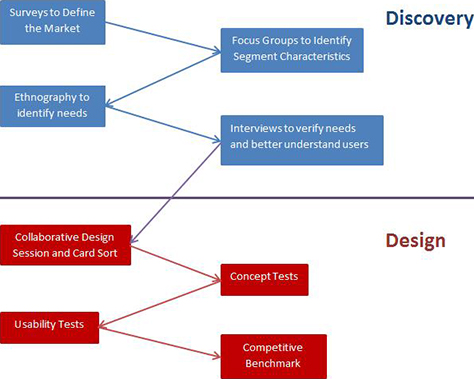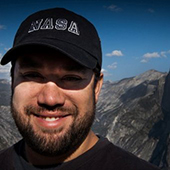Research Phases
For a User Experience team, the key phases of a product development cycle are Discovery and Design. Discovery consists of defining the market for a product, its potential users, and product requirements. Common user research approaches during the Discovery Phase include survey research, focus groups, expert interviews, and ethnography.
The Design Phase involves bringing a product to life through product or user interface design and refinement. User research during the Design Phase focuses on gaining a deeper understanding of users, confirming research findings from the Discovery Phase, identifying the relative value of various features, and refining a design as it evolves. Common user research methods during the Design Phase include concept testing, usability testing, and competitive benchmarking.
Understanding the different challenges you’ll need to address during these different phases allows you to plan your user research effort throughout a development cycle.
Planning ahead of time lets you prepare for user research studies in advance, reducing the time and effort you must devote to a given research activity. For example, once you’ve identified your target users, you can start building participant lists and networks to facilitate recruiting. When preparing for your first study, you must establish communication with many potential participants and select study participants from that pool of participants for your study. Once you’ve established that participant pool, it becomes easier to find participants for subsequent studies, simplifying your recruiting efforts, reducing the man-hours you must devote to contacting potential participants, and shortening your research schedule. Over the course of multiple studies, this preparation pays enormous dividends.
Discovery Phase
The main goal of the Discovery Phase is to define the product your team is developing. To do that, you must understand the market and the needs of users within that market. Therefore, the first step in planning user research is understanding your team’s information needs. Your organization’s business goals always drive its need for user research. Understanding these goals and needs is a little more difficult during the early part of the Discovery Phase, before you’ve even defined a product concept.
At this early stage, your business goals tend to focus on serving a given market. So, through your user research, you should endeavor to understand that market, define its segments, model the users belonging to them, and learn about the needs of those users. Surveys are an effective way of getting an overview of a market and understanding its characteristics. Through the results of a survey, you can define your market size, identify market segments, and define the demographics of the different segments. However, surveys can tell you very little about user needs and behavior.
Following your survey research, you’ll need to learn more about users and their behavior. Your best option for identifying users’ needs is some form of contextual user research. Performing any kind of needs-finding research that uses self-reported data—including interviews, surveys, and focus groups—is notoriously unreliable. People have a great deal of difficulty being objective about their own lives, and they tend to be blind to the workarounds they employ in meeting their needs.
If you ask people what they need, they’ll tell you a better, faster, and cheaper version of what they already have. Steve Jobs![]() was famous for saying, “People don't know what they want until you show it to them.” Contextual research approaches such as ethnography or interviews that you conduct within the context of product use, whether at home or in the office, circumvent this difficulty by letting you directly observe users. This allows you to identify needs from their actual behavior. This kind of research can also provide quite a bit of information about a user’s environment and behavior, which can help you to further define a product.
was famous for saying, “People don't know what they want until you show it to them.” Contextual research approaches such as ethnography or interviews that you conduct within the context of product use, whether at home or in the office, circumvent this difficulty by letting you directly observe users. This allows you to identify needs from their actual behavior. This kind of research can also provide quite a bit of information about a user’s environment and behavior, which can help you to further define a product.
Once you’ve identified a need, the next step is determining the best way to meet that need. At this point, you define the product. The product’s primary features usually target meeting the identified user needs in some way. The nature of the needs often determines the form the product takes. For example, if a need tends to arise when a user is in a coffee shop or walking around outside, the product would likely be a mobile app or a portable device. When defining a product, user research focuses on learning more about current user behavior and verifying identified needs through additional interviews, focus groups, and other forms of generative research. Finally, you must gain as deep an understanding of your users as possible to inform design. This includes identifying additional desirable features and defining the scope of a product’s complete feature set. It is during this phase of research that you might decide to develop personas.


